Kazuhiro Hayashi (National Institute of Science and Technology Policy)
Yuko Nagai (Zoological Society of Japan)
Mikiko Tanifuji (National Institute for Materials Science)
The authors are members of the Sub-committee on Journal Issues, Committee for Scientific Community of the Science Council of Japan (SCJ).
As of FY2013, the “scientific periodicals” category of the grants-in-aid for publication of scientific research results (kakenhi, in Japanese) of the Japan Society for the Promotion of Science (JSPS), has been renamed “programs for strengthening the capacity for international information transmission,” and its contents have been extensively revised. Here, we present a preliminary report on a survey, conducted in December 2012 by the Subcommittee for Journal Issues of the SCJ Committee for Scientific Community, in which the SCJ’s constituent science and research organizations were asked to report their reactions to the changes. Timed so that it went out shortly after applications closed for this section of the grants-in-aid program, the questionnaire focused on how these bodies view the revisions and how they have responded.
Figure 1 outlines the changes to this grant category. Where previously, in effect, grants were assumed to be for print journals only, and even then only for certain specified production costs, the new system provides flexible support for strengthening the capacity for the international dissemination of information, including the use of electronic formats.
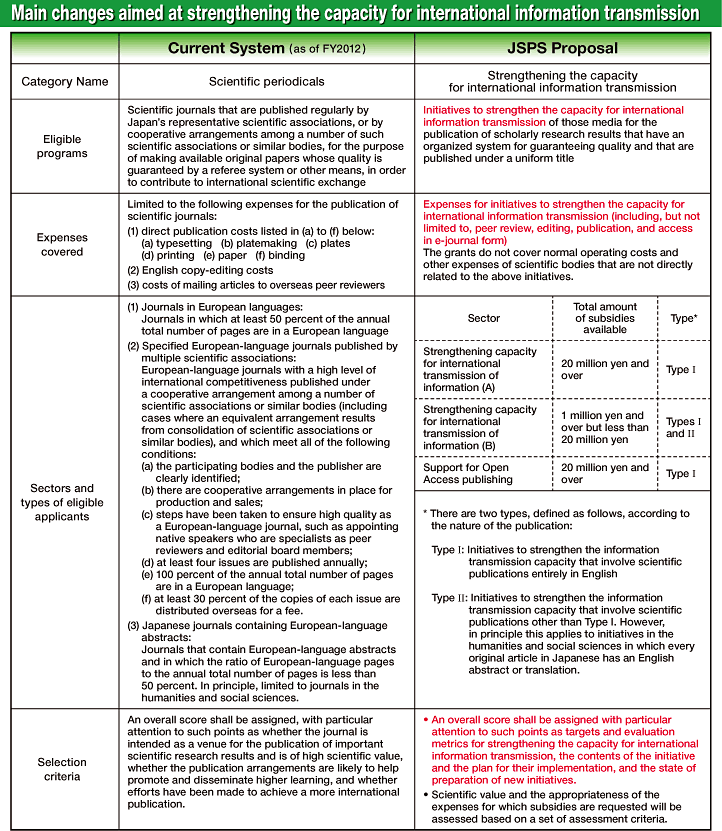
Figure 1: Comparison of the old and new systems
Source: 6th-Term Research Funding Division Council for Science and Technology, MEXT, (6th session), handout no. 3, “Kagaku Kenkyūhi Josei Jigyō (Kenkyū Seika Kōkai Sokushinhi) no kaizen’an ni tsuite” (On the proposal for improvement of the kakenhi grants-in-aid program [Grants-in-Aid for Publication of Scientific Research Results])(Report of the JSPS).
http://www.mext.go.jp/b_menu/shingi/gijyutu/gijyutu4/022/gijiroku/1320285.htm
|
In 2008, the SCJ Subcommittee for Journal Issues, on which the present authors serve, drew up concrete recommendations for the strengthening of Japanese journals. The new policy on government subsidies reflects these recommendations, and that fact was one motive for the present survey, together with the desire to assist in developing further measures toward strengthening the international dissemination of information based on results achieved following the adoption of the new system this spring. |
|
● Outline of the Questionnaire |
● Basic Information about the Questionnaire |
|
|
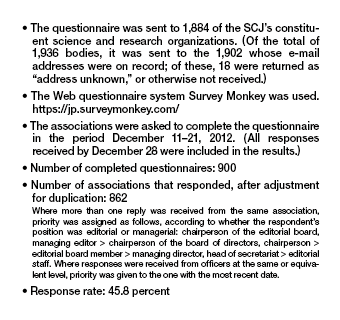
Figure 2: Basic data regarding the questionnaire |
|
Figure 2 shows the basic data regarding the survey. To obtain as many responses as possible, the questionnaire was designed to take about 10 minutes and thus included only the most fundamental and important questions. The result was a relatively high response rate of 45.8 percent (862 associations). |
|
● The Design of the Survey |
|
|
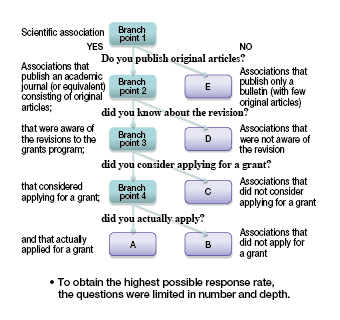
Figure 3: Survey design |
|
Although they are all classified as “scientific associations,” the organizations surveyed do not have a great deal in common; indeed, their cultures and practical situations are quite disparate. In designing the survey, we assumed that associations with a publication of their own (a bulletin or academic journal) would make up the bulk of the respondents, and that these publications would mainly be journals consisting of original articles, which are eligible for the grants. The first question (branch point 1) was designed to sort the respondents along these lines. Those that do issue a publication were then asked whether they were aware of the revision (branch point 2), whether they had considered applying (branch point 3), and whether they had actually applied (branch point 4). As shown in Figure 3, this branching divided the respondents into five groups:
・ A: Associations that applied for grants
・ B: Associations that considered but did not apply for grants
・ C: Associations that were aware of the revision but did not consider applying for a grant
・ D: Associations that were not aware of the revision
・ E: Associations that publish only a bulletin with few original articles
|
Each group was then asked a different set of additional questions. The tabulated results, which are presented in part here, are available on the SCJ’s website. The link can be found at the end of this article, together with links to materials that document the process leading to the revision of this section of the grants-in-aid program. |
|
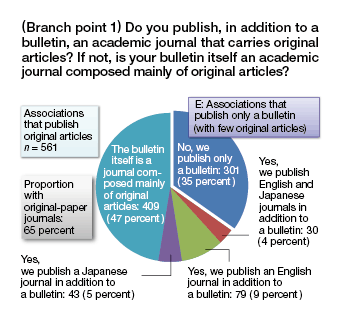
Figure 4: Branch point 1-1 |
|
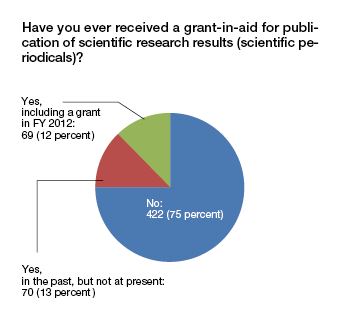
Figure 5: Branch point 1-2 |
Figure 4 shows the results of the first branching. The question of whether the SCJ’s constituent science and research organizations publish a medium that carries original articles (a bulletin or academic journal) had not received much attention, but this survey makes it clear that 65 percent of the respondents do so. Further, 75 percent of the associations that publish journals reported that they had never received a grant-in-aid (Figure 5). |
|
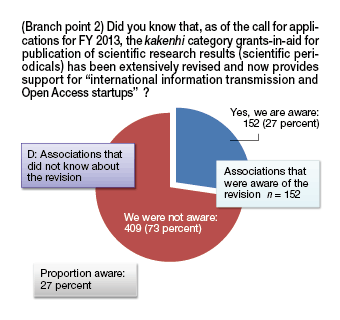
Figure 6: Branch point 2-1 |
|
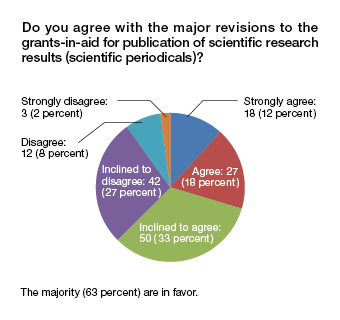
Figure 7: Branch point 2-2 |
The question about awareness of the revision yielded the most striking results in the survey. As many as 73% of the respondents were unaware of the revisions. The underlying reason for this may be that a similar number had never received a grant-in-aid. The majority of the associations that were aware of the revision were in favor of it (Figures 6 and 7).
|
|
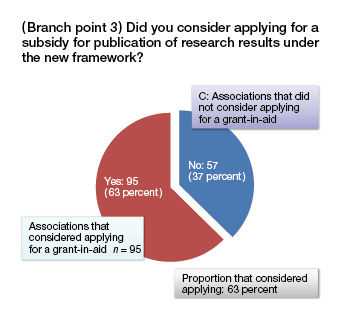
Figure 8: Branch point 3-1 |
|
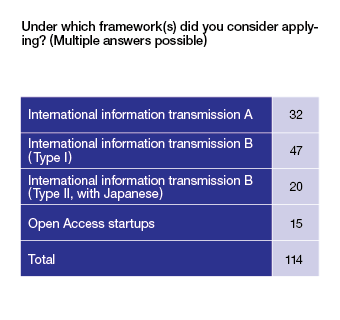
Figure 9: Branch point 3-2 |
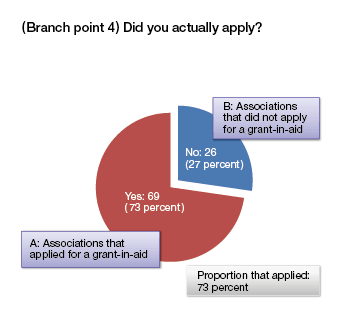
Figure 10: Branch point 4 |
|
When asked whether they had considered applying for a grant-in-aid (branch point 3), 63 percent reported that they had (Figures 8 and 9); of these, 73 percent had actually applied (branch point 4, Figure 10). Can these numbers be interpreted as suggesting that the revisions have been accepted by scientific associations? |
|
● Breakdown by category |
A: Associations that applied |
|
|
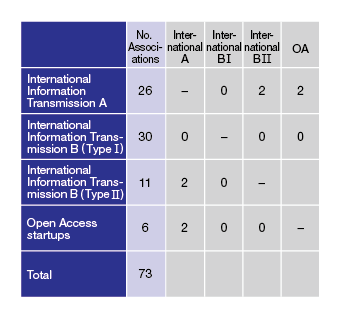
Figure 11: Categories in which they applied (Some applied in more than one category.) |
|
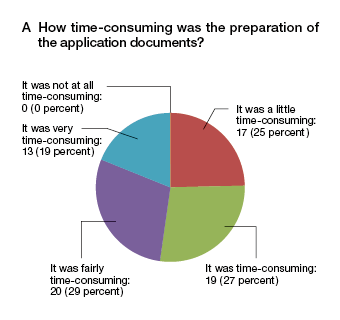
Figure 12: Preparation of the application |
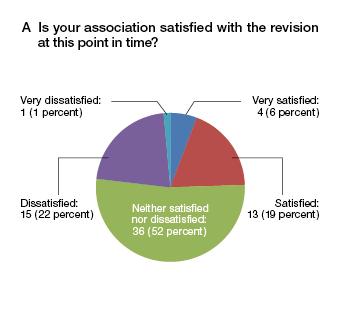
Figure 13: Level of satisfaction with the revision |
|
At branch point 4, it was determined that 69 associations had actually applied for a grant-in-aid. Figure 11 shows their applications broken down into categories; a few associations had applied in more than one. Most respondents had found the application forms time-consuming to complete (Figure 12); this is no doubt partially due to the fact that the forms were very different from those used until FY 2012. The majority gave a neutral response regarding their level of satisfaction with the revision at this point; those that did take a position were divided more or less equally between satisfied and dissatisfied (Figure 13). We would like, if possible, to pursue questions in these areas in more depth with the associations that actually applied, including issues for the future and suggestions regarding the forms. |
|
B: Associations that considered but did not apply for a grant-in-aid |
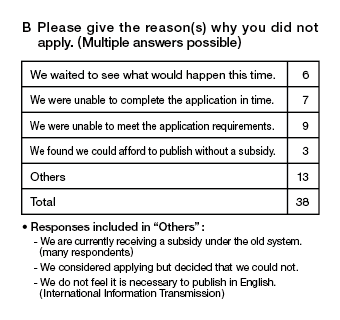
Figure 14: Reasons why associations did not apply |
|
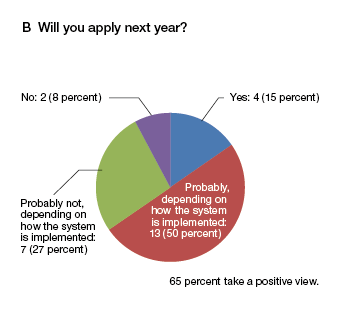
Figure 15: Plans for FY 2014 |
The associations that had considered applying but had not done so were asked why they did not, and what they were most likely to do next year (Figures 14 and 15). As for why organizations did not apply, there clearly are a variety of reasons depending on the particular circumstances of each organization. If we combine those that had already decided to apply with those that chose the option “Probably, depending on how the system is implemented,” more than half of respondents indicated they would apply next year. We intentionally created that second qualified option, and that qualifier can be construed in various ways. In further surveys we intend to take up this point by asking more specific questions and identifying the essential issues. |
|
C: Associations that knew about the revision but did not consider applying for a grant-in-aid |
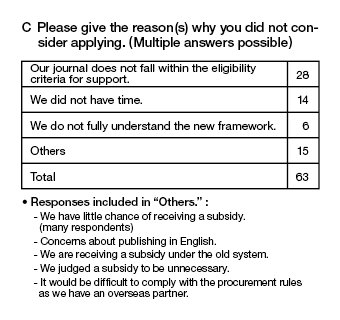
Figure 16: Reasons why associations did not consider applying |
|
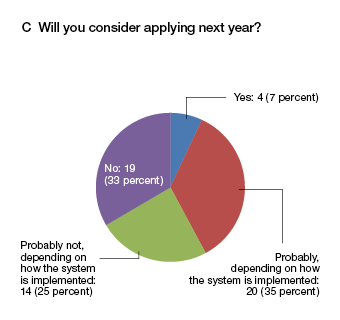
Figure 17: Plans for FY 2014 |
Those associations that were aware of the revisions but did not consider applying were also asked why they did not, and what they planned to do next year (Figures 16 and 17). The most frequent response was that the association’s journal did not meet the eligibility criteria; the second most frequent was lack of time. There may be some associations that mistakenly believe they are ineligible, in which case public relations work is needed to remedy the situation by providing accurate information about the grants’ framework, significance, and intended recipients. |
|
D: Associations that did not know about the revisions |
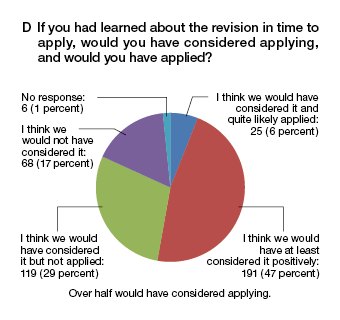
Figure 18: Likely response if they had known about the revision |
|
Associations that were not aware of the revision were asked whether they would have considered applying if they had known (Figure 18). The results indicate that over half might well have applied, or at least considered it. The FY2013 estimated annual budget of the Ministry of Education, Culture, Sports, Science and Technology (MEXT) calls for increased funding for this section of the grants-in-aid program, and it is hoped that the number of applications will increase; thus, public relations work will be necessary to keep this group of potential applicants informed. |
|
● Discussion |
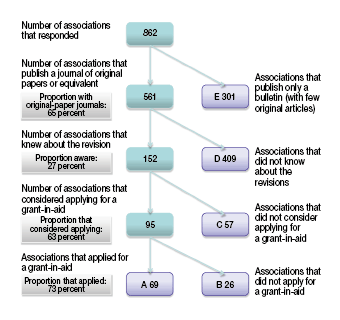 Figure 19: Summary of questionnaire results Figure 19: Summary of questionnaire results
Figure 19 shows schematically how the questionnaire respondents divided into groups. A total of 65 percent of the associations either had a bulletin that was an academic journal consisting mainly of original papers, or published such a journal in addition to a bulletin. This serves to remind us that scientific associations are diverse, and not all of them were eligible at this time to apply for this category of grants-in-aid.
When informed of the major revisions of the grants-in-aid program intended to support their publishing endeavors, scientific associations for the most part viewed the change positively. However, over 70 percent of the associations for whom the grants are intended were unaware of the revisions, and about half of those said that, had they known, they might have considered applying—results that suggest a need for systematic efforts to increase the visibility of the new grants.
Applications under the old grants-in-aid for publication of scientific research results (scientific periodicals) system had been declining for some time, as competitive bidding had been made mandatory for amounts over 1 million yen in recent years, and the application and accounting requirements had become increasingly complex. It would also be fair to say that the bar had been steadily raised, year after year, each time the grant system was reviewed; the competitive bidding requirement is just one example. As a consequence, a number of associations had already stopped applying, and that may explain why they had not heard of the recent revisions, while those that intended to apply again under the old system in 2013 remained better informed. It may also have been a question of timing: a number of associations may not have applied because the information necessary for them to prepare was not readily available to them with sufficient lead time.
The revision represented a fundamental rethinking of the very nature of the subsidies, a reexamination of their role in supporting the publication of Japanese journals, and when it came to writing their applications, the associations must have had to spend a considerable amount of time on internal debate and examination of how to put together the application. It is noteworthy that 73 percent of those that considered applying eventually did so. If the number of applications has in fact increased, the revision could probably be said to have been a success so far.
As the new names of the grants indicate, the main focus of the revision is strengthening the capacity for international transmission of information. The application requirements have been redesigned to attune the grants to the electronic publishing era, and the division into three sectors—International Information Transmission (A and B) and Open Access publishing—also reflects the focus on strengthening this capacity. It is hoped that the new subsidy system will help concretely fulfill the demands made on journals in the present-day environment, where scientific fields are highly diversified and associations have their own internal cultures. In particular, grants for Open Access startups are a landmark provision in that the government is offering financial support for the transition from the subscription model to the OA model based on the article processing charge (APC), that is, a model in which the author pays all or part of the publication costs and the article is made available at no charge to users. It should also be noted that many of the associations that applied for the new grants found the process less than straightforward. There were limits to how in-depth the individual response groups could be questioned in this survey, but we hope that, in order to make better use of this section of the grants-in-aid program, the JSPS will seek out the opinions of researchers (especially those whose associations publish journals, and their managing editors or the chairs of their editorial boards) with regard to how they would like to see the international transmission of information strengthened, and that it will utilize this knowledge to improve the system and streamline the application procedure. It is also noteworthy that a few scientific associations have stated that they do not require subsidies. We intend to continue following developments with regard to such issues as the possible forms of financial self-sufficiency for journal publishing by scientific associations as we seek an overview of the future of Japan’s journals, both subsidized and nonsubsidized.
|
● In Conclusion |
In Japan, discussion has tended to focus on “scientific journals” as if this was a uniform category, but in reality such publications reflect the diversity of the associations that publish them, each of which has its own history, culture, and philosophy and forms part of a complex web of relationships and differences among fields. As these journals confront the rapid changes that are transforming scholarly communications in other countries, the present revision of the grants-in-aid system aimed at helping to strengthen them in their various individual contexts is undoubtedly a significant step. At the same time, an important task remains to be addressed: how to make available and archive the valuable body of scientific literature written in the Japanese language.
Note
This article represents the personal views of the three authors in the context of their participation in the discussions of the SCJ Subcommittee for Journal Issues; it does not necessarily represent the views of the SCJ.
|
|
|
● For information concerning the kakenhi revision and related matters: |
MEXT
| ● |
Gakujutsu jōhō no kokusai hasshin, ryūtsūryoku kyōka ni muketa kiban seibi no jūjitsu ni tsuite” (Infrastructure Development for Strengthening the Capacity of International Scholarly Communication), accessed July 26, 2012.
http://www.mext.go.jp/b_menu/shingi/gijyutu/gijyutu4/toushin/1324880.htm |
| ● |
Kenkyūhi Josei Jigyō (Kakenhi) no arikata ni tsuite (shinsa no matome sono 2)” (On the ideal form of the Grants-in-Aid for Scientific Research [Kakenhi]; Summary of deliberations, part 2), accessed July 25, 2012.
http://www.mext.go.jp/b_menu/shingi/gijyutu/gijyutu4/toushin/1324540.htm |
| ● |
MEXT Science and Technology Policy Bureau, Research Promotion Bureau, and Research and Development Bureau, “Heisei 25-nendo Monbu Kagakushō gaisan yōkyū tō no happyō shiryō ichiran, 09-8 Heisei 25-nendo gaisan yōkyū no gaiyō 8” (Table of published documents concerning FY 2013 MEXT estimated annual budget and related matters, 09-8 Outline of FY 2013 estimated annual budget 8) (September 2012).
http://www.mext.go.jp/component/b_menu/other/__icsFiles/afieldfile/2012/09/20/1325571_08.pdf |
Science Council of Japan
| ● |
“Kakenhi Seika Kōkai Sokushinhi no kaitei ni kansuru gakukyōkai no ishiki chōsa” (Opinion survey of scientific associations regarding the revision of the Kakenhi Grants-in-Aid for Publication of Scientific Research Results).
http://www.scj.go.jp/ja/member/iinkai/kiroku/1-250214.pdf
|
Japan Society for the Promotion of Science
| ● |
“Heisei 25-nendo Kagaku Kenkyūhi Josei Jigyō: Kakenhi Kenkyū Seika Kōkai Sokushinhi ‘Gakujutsu Teiki Kankōbutsu’ no kaisei ni kansuru setsumeikai” (Explanation meeting concerning the revision of the FY 2013 Grants-in-Aid for Scientific Research: Kakenhi Grants-in-Aid for Publication of Research Results (Scientific Periodicals).” Accessed May 16, 2012.
http://www.jsps.go.jp/j-grantsinaid/06_jsps_info/g_120507/index.html |
| ● |
“Heisei 25-nendo Kagaku Kenkyūhi Josei Jigyō: Kakenhi Kenkyū Seika Kōkai Sokushinhi ‘Kokusai Jōhō Hasshin Kyōka’ oyobi ‘Dētabēsu’ no kōbo ni kansuru setsumeikai” (Explanation meeting concerning the call for applications for the FY 2013 Grants-in-Aid for Scientific Research: Kakenhi Grants-in-Aid for Strengthening the Capacity for International Information Transmission and for Databases). Accessed October 9, 2012. http://www.jsps.go.jp/j-grantsinaid/06_jsps_info/g_120901/index.html |
SPARC Japan
| ● |
Nagai Yūko, “The role of association journals in Japan: The future of periodicals subsidized under the Kakenhi Grants-in-Aid for Publication of Scientific Research Results.” SPARC Japan Newsletter 11, 2012, pp. 5–10. |
| ● |
3rd SPARC Japan Seminar 2012, “Heisei 25-nendo Kagaku Kenkyūhi Hojokin (Kenkyū Seika Kōkai Sokushinhi) kaikaku (Reform of the FY 2013 Kakenhi Grants-in-Aid for Publication of Research Results). Accessed July 25, 2012. http://www.nii.ac.jp/sparc/event/2012/20120725.html |

|

